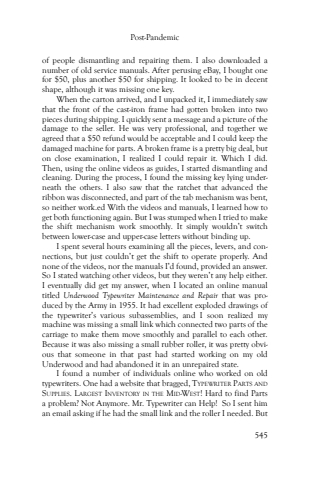Page 551 - Demo
P. 551
Post-Pandemic545demand for typewriter sales and repair work. As a result, in 1946 he was one of Remington Rand%u2019s top typewriter salesmen.In the beginning, Dad operated his business out of his home with a neatly lettered sign planted in the yard by the side door proclaiming THE GREGORY R. BOWER CO., TYPEWRITERS, ADDINGMACHINES, REPAIRING. But what I remember is the small two-room building he rented later near Fowler%u2019s downtown. He worked at a heavy steel workbench (which in now in my garage). It was fitted with a swivel stand on which he could easily rotate a machine from front to back. To clean an old typewriter, he%u2019d remove all the rubber parts, and the key covers, then soak the machine in a product called Stanisol, which was a smelly solvent he got from the Standard Oil gas station. Years later, I used the same stuff when working on my hot rod to remove oil and grease when I was working on something like a steering box, engine, transmission, or differential. After soaking a typewriter overnight, he blow it off with his air hose before placing it in a heated cabinet to dry. Once clean and dry, he%u2019d reinstall the components he%u2019d removed earlier, then repair, oil, and adjust.For the first few years after we moved to Lafayette in 1955, Dad still did repairing himself, but as the business expanded and evolved, and other responsibilities required more of his time, he hired a man named Floyd Johnson to do the typewriter repair and maintenance work. Floyd had another job somewhere, and Dad only used him as needed, on a part-time basis. On one occasion, a customer phoned to ask if their machine was ready yet, and Dad had forgotten to give Floyd a call. Rather than admit that the typewriter was still just sitting on a shelf, he said, %u201cIt%u2019s not repaired yet, we had to order a special part, and are waiting for it to come in.%u201d I don%u2019t know what Dad charged when I was young, but I recall an incident from when I was in high school. He took in an older typewriter for repair, and as soon as the customer left, he quickly made the simple fix himself, without giving Floyd a call. He told me he was going to charge $25, saying, %u201cThat%u2019s two dollars for the part, and $23 because I knew which part to replace.%u201d Then he added, %u201cI%u2019m going to wait a few days before I call them to come pick it up, so they won%u2019t realize how easy it was.%u201d This was in the 1960s, when


